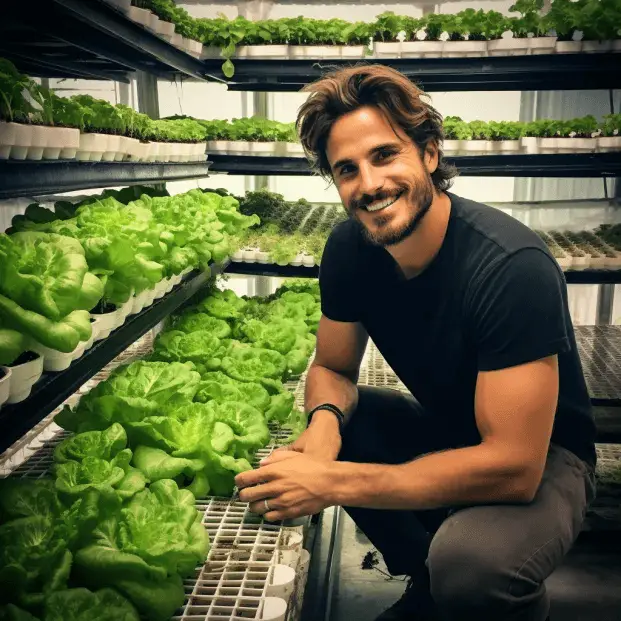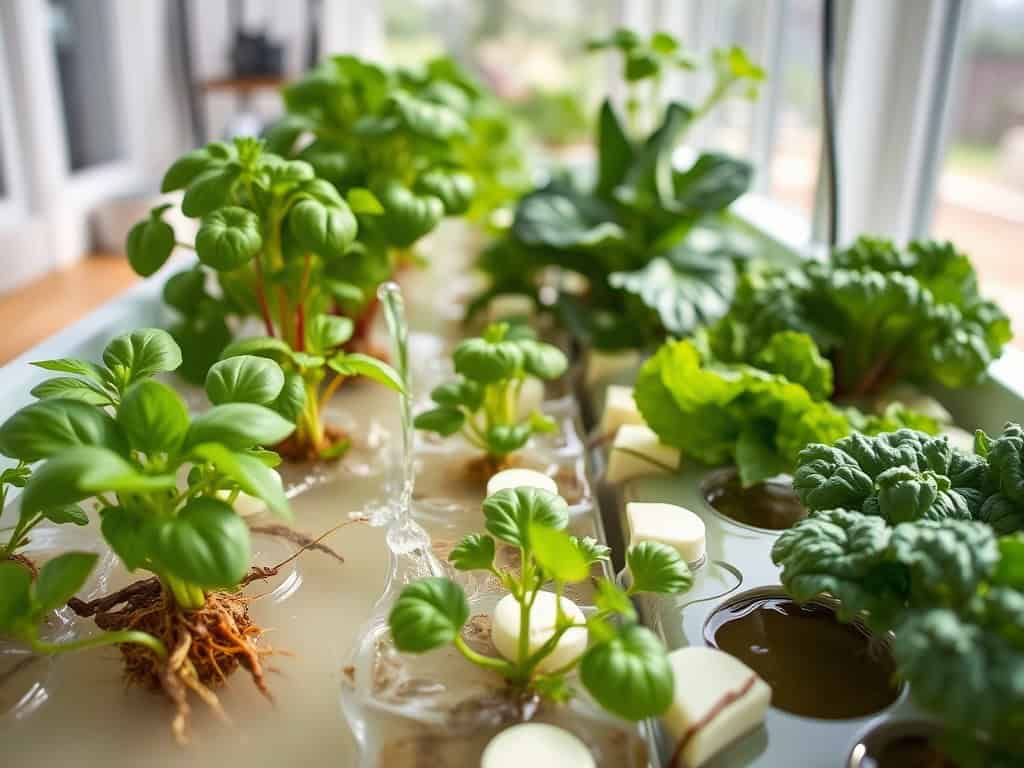NFT hydroponics offers a great solution for beginners wanting to grow plants without soil. This method saves space and is perfect for those who love gardening but have limited room. Research shows it uses up to 90% less water than traditional gardening methods.
Imagine being able to enjoy fresh herbs and vegetables right at home while being environmentally friendly. Setting up an NFT system is simple, and with a little guidance, anyone can do it. Curious about how to get started? Keep reading to discover the steps for creating your own NFT hydroponics system!
Key Takeaway
- NFT is a simple hydroponic method that uses a nutrient-rich water film.
- It works best for small plants with shallow roots, like lettuce and herbs.
- Regular checks on system health ensure your plants grow strong and healthy.
What is Nutrient Film Technique (NFT)?
Credits: Hoocho
NFT is a hydroponic method that allows plants to grow without soil. Instead of dirt, plants receive their nutrients from a thin film of water mixed with nutrients. This water flows over the roots, which sit in shallow channels or tubes. This setup helps plants easily absorb water, nutrients, and oxygen.
Since NFT uses very little growing medium, it’s an excellent choice for gardeners looking to make the most of their space. With its efficient design, this system can produce healthy plants quickly, making gardening more accessible and enjoyable for everyone.
Key Components of an NFT System
- Grow Channels: Grow channels are shallow trays or tubes where plants are placed. They are slightly sloped to help the nutrient solution flow smoothly downwards. This design keeps the roots moist while allowing some of them to get air, which is vital for healthy growth. This setup plays a crucial role in ensuring plants thrive.
- Reservoir: The reservoir is where the nutrient solution is stored. It needs to be opaque so light can’t get in, which helps stop algae from growing. The size of the reservoir is important too; it must be large enough to supply plenty of water for the entire system. A bigger reservoir creates a more stable environment for the plants.(1)
- Water Pump: The water pump is necessary for moving the nutrient solution from the reservoir to the grow channels. It needs to work consistently because if it fails, plants can run out of nutrients quickly. Regular checks on the pump help catch any issues before they become serious problems.
- Net Pots: Net pots hold the plants and allow the roots to hang down into the nutrient film. These pots can be filled with lightweight growing media, like rockwool or clay pebbles. However, NFT systems often use just a small amount of media, enhancing aeration and making it easier for roots to absorb nutrients.
- Return System: The return system gathers any extra nutrient solution from the grow channels and sends it back to the reservoir for reuse. This recycling helps maintain efficiency and keeps costs down over time, making gardening more sustainable.
How Does NFT Work?
In an NFT system, the nutrient solution flows continuously over the roots of plants that hang in grow channels. The process begins with the water pump pulling nutrient solution from the reservoir. Then, the solution travels through tubes to reach the grow channels. (2)
Once the solution reaches the channels, it flows down the slope, nourishing the roots of the plants. After the roots absorb the nutrients they need, any leftover solution drains back into the reservoir. This setup keeps a thin film of water around the roots, providing nutrients while making sure part of the roots is exposed to air for much-needed oxygen.
Overall, the constant flow of water supports quick and healthy plant growth. This system makes it easier for beginners to grow their own food without the struggles of traditional gardening.
Advantages of NFT
- Water Efficiency:
One of the main benefits of NFT systems is how well they save water. These systems use up to 90% less water than traditional soil gardening. They recycle the water instead of letting it drain away completely. For anyone wanting to conserve water, NFT is a fantastic option.
- Oxygenation:
NFT systems give roots plenty of air. With some parts of the roots exposed, they can easily absorb oxygen. This is essential for healthy root growth. The blend of water and air helps plants stay strong and vibrant. (3)
- Space-Saving:
NFT systems can be set up vertically, taking up less space overall. This makes them perfect for small gardens or urban spots where space is tight. By growing plants vertically, gardeners can maximize their available area.
- Simplicity:
After the initial setup, NFT systems are quite easy to maintain. They require less effort compared to other hydroponic methods like Ebb and Flow. This straightforwardness makes NFT a great choice for beginners who may feel overwhelmed by more complicated systems.
- Rapid Growth:
Many plants tend to grow faster in NFT systems because they have constant access to nutrients and ideal growing conditions. This efficiency can lead to quicker harvests, providing new gardeners with the results they are eager to see.
Considerations for Beginners
- Plant Selection:
When starting with NFT, choosing the right plants is key. Smaller plants with shallow roots, like lettuce, basil, mint, and strawberries, thrive best in this system. Larger plants may require more support than NFT can provide, so beginners should focus on smaller varieties to increase their chances of success.
- Monitoring System Health:
Regularly checking the health of the system is vital for plant growth. Beginners should keep an eye on pH levels, nutrient concentration, and water temperature, as these factors can impact plant health. Maintaining the right conditions helps ensure a thriving crop.
- Potential Risks:
There are some risks to keep in mind when using NFT. If the pump fails or there’s a blockage in the system, plants can wilt quickly due to a lack of nutrients. Having backup systems or alarms can be helpful to mitigate these risks and keep the plants safe.
- Initial Setup Costs:
While NFT systems can save money on water and nutrients in the long run, the initial setup costs may be higher. Equipment like pumps and reservoirs can add up. Beginners should budget for these expenses as they start their hydroponic journey.
- Maintenance:
Regular maintenance is essential to keep the NFT system running smoothly. Channels should be cleaned often, and it’s important to watch for algae growth. Taking care of these details will help ensure the system remains efficient and productive.
Conclusion
The Nutrient Film Technique offers beginners a straightforward and effective method for growing plants hydroponically. By learning about its key components and how the system operates, anyone can start gardening without soil. With the right setup and regular care, NFT systems can yield healthy crops while conserving water and resources.
This approach simplifies gardening, making it accessible for those new to the hobby. Plus, its efficiency allows users to enjoy the benefits of fresh produce right at home, enhancing their gardening experience without the hassles of traditional methods.
FAQ
What is the nutrient film technique (NFT) in hydroponics?
The nutrient film technique, or NFT, is a hydroponic growing method where a thin stream of nutrient-rich water flows over plant roots, allowing them to absorb nutrients without soil. This system helps provide continuous access to nutrients, oxygen, and water, making it efficient for growing leafy greens and herbs.
Is NFT hydroponics suitable for beginners?
Yes, NFT systems can be beginner-friendly, especially with some basic setup knowledge. While NFT requires attention to water flow and nutrient levels, it’s one of the simpler hydroponic methods, particularly when growing smaller plants with shallow roots.
What types of plants grow best in an NFT system?
NFT works best for plants with smaller root systems, like leafy greens, herbs, and some strawberries. These plants thrive in a constant nutrient flow. Large plants or those with extensive roots may struggle in NFT, as the root space is limited.
How does the nutrient solution work in NFT?
In NFT, a pump sends a nutrient solution through a channel where plant roots are exposed to a thin “film” of it. The roots absorb the nutrients they need, while the excess solution returns to the reservoir, creating a recirculating system that minimizes waste.
Do NFT systems need a lot of maintenance?
NFT systems require regular checks on water flow, pH levels, and nutrient concentration. Pumps need to stay functional, and nutrient solutions should be refreshed regularly to prevent buildup. While not high-maintenance, NFT requires consistent attention for best results.
What equipment is needed to set up an NFT system?
An NFT system typically needs a water pump, reservoir, growing channels (usually PVC pipes), a nutrient solution, and a timer. You’ll also need pH and nutrient testers to monitor levels. Basic setups can be DIYed, or you can buy pre-made systems.
How often should I check the nutrient levels in an NFT system?
It’s best to check nutrient levels at least once a week. Changes in temperature or plant growth rate can affect nutrient use, so weekly checks help ensure plants get consistent nutrition. Adjust levels if you see signs of deficiency, like yellowing leaves.
Are there common issues to watch for in NFT systems?
Yes, issues like pump failure, nutrient buildup, or root clogging can happen. If the pump stops, plants can dry out quickly. Regularly check your system for good water flow, and clear any blockages to keep roots healthy and hydrated.
Referencess
- https://hydragarden.com/blogs/blogs/hydroponic-nutrient-film-technique-nft-a-beginners-guid?srsltid=AfmBOooWRPaHhStbXyO17GiihTbdgibTn3omk0c-TKaLtqVu7z702CRT
- https://acornhorticulture.com/nft-hydroponics-a-beginners-guide/
- https://hydroplanner.com/blog/how-hydroponics-can-be-done-diy-guide
Related Articles
- https://tophydroponicgarden.com/nutrient-film-technique/
- https://tophydroponicgarden.com/hydroponics-for-beginners/
- https://tophydroponicgarden.com/nutrient-film-technique-setup/
Was this helpful?

I’m Barrie L., a passionate hydroponic gardening enthusiast dedicated to cultivating thriving, soil-less gardens. With a focus on all things hydroponic, I share my expertise on innovative growing techniques and sustainable practices through my blog, tophydroponicgarden.com. As a seasoned hydroponics specialist, my goal is to inspire and guide fellow gardeners in harnessing the power of water-based cultivation for bountiful and eco-friendly harvests. I’m also an author of the book “Hydroponics For Absolute Beginners: Your Step By Step Guide For How To Create An Hydroponics System At Home Without Soil, For Growing Vegetable, Fruit And Herbs.” which is sold on Amazon. Join me on a journey of redefining the way we cultivate plants, one nutrient-rich solution at a time. Happy growing!


